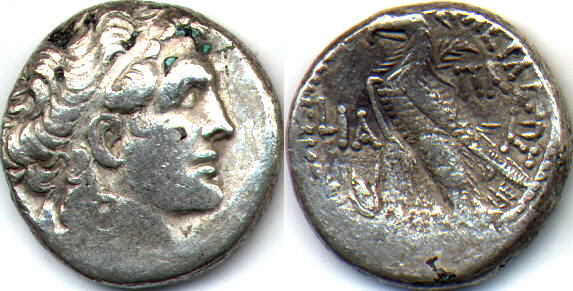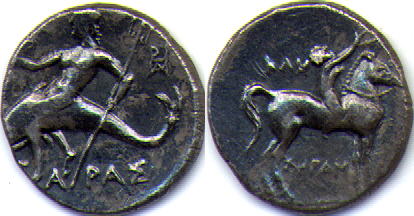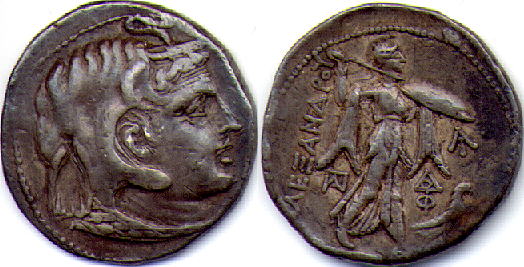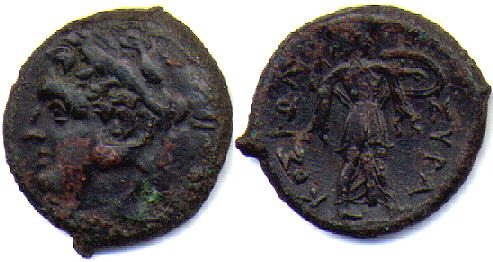Coins of famous ancient rulers
In alphabetical order
Alexander III the Great
Born 356 B.C. , King of Macedonian Empire 336-323 B.C. 
Silver Tetradrachm
O: Head of young Herakles right, wearing a lion's skin.
R: Zeus seated left on backless throne, holding eagle and scepter.
In the left field, a Herm.
This particular coin was struck at Amphipolis, c. 336-323 BC.
Nearly identical coins were struck for years after his death, with relatively
minor differences involving control marks seen on the reverse. (The
Herm is the control mark on this particular coin.) No coins issued
during Alexander's lifetime bear his portrait. For an early coin
with his portrait, see Ptolemy I.
Alexander III of Macedonia, one of the greatest conquerors of all time,
conquered the Persian empire and annexed it to Macedonia.
The son of Philip II, Alexander was presented
to the army as king in 336 BC, upon the mysterious assassination of his
father. He proceeded to conquer most of the known world, bringing
Greek armies as far as India within the next ten years. He died of
fever in Babylon, without naming a successor.
Antiochus IV Epiphanes
Born c. 215 B.C., Seleucid King 175-164 B.C.
Silver tetradrachm (4-drachm piece) of Antiochus IV. 30 mm.
O: Head of Antiochus IV facing right.
R: Zeus enthroned, legend in Greek.
Antiochus IV was the Seleucid king whose attempts to introduce pagan rites in Jerusalem led to the revolt of the Maccabees and the creation of a Jewish state. The son of Antiochus III, he had to defeat the usurper Heliodorus before taking power in 175. In 171 he invaded Egypt, but he was later driven out by the Romans. Antiochus also campaigned against the Parthians.
The Maccabees were a family of priests from a village near Jerusalem who, in 168 BC, instigated an uprising to defend Judaism against both the Seleucids. The uprising began when the aged Mattathias killed an apostate Jew who was about to offer sacrifice to Zeus on an altar set up by Antiochus IV in the Temple precincts at Jerusalem. Mattathias's five sons carried on the uprising, including Judas ("Judah the Maccabee"). Judas won several victories over Syrian armies and, in 164 BC, occupied the Temple in Jerusalem, building a new altar and fortifying the area. This remarkable event continues to be celebrated as Hanukkah.
The revolt of the Maccabees gave rise to a Jewish state, which was ruled by descendants of the Maccabees (the Hasmonean Dynasty) until 37 BC. Judah the Maccabee did not strike coins; the first Hasmonean to do so was Alexander Jannaeus, his great nephew.
Cleopatra VII, Queen of Egypt
Born 69 B.C., Ruled Egypt, 51-30 B.C.

Debased silver tetradrachm (4-drachm piece), 25 mm
Obverse: Head of
Ptolemy I facing right.
Ptolemy I was a general of Alexander the Great,
and founded the Ptolemaic dynasty.
Reverse: Eagle on thunderbolt (the badge of the Ptolemies).
A palm branch is behind the eagle's shoulder. The coin has a date
in Greek: LIA, or year 11 of Cleopatra's rule. This corresponds to
41-40 BC.

Copper 80 Drachms, 26 mm (480 copper drachms were the equivalent of
one silver drachm)
O: Head of Cleopatra facing right.
R: Eagle on thunderbolt.
Existing coin portraits of Cleopatra are not very flattering, at least
by modern standards. Cleopatra's legendary powers of seduction were
likely due to her charisma, intelligence, and personality, rather than
physical beauty.
Cleopatra was the name of the seven queens of ancient Egypt's Ptolemaic
dynasty. By far the most famous was the last of the Ptolemaic dynasty,
Cleopatra VII. She made extraordinary efforts to revive Ptolemaic
power through her forceful personality and political skill, efforts which
involved or led to romantic liaisons with both Julius
Caesar and Mark Antony. Her life and death
at her own hand have been the subject of much literature, including William
Shakespeare's Antony and Cleopatra and George Bernard Shaw's Caesar
and Cleopatra.
The daughter of Ptolemy XII, Cleopatra became joint ruler with her
younger brother Ptolemy XIII in 51 BC. Three years later they fought each
other in a civil war, during which time Cleopatra was briefly expelled
from Egypt. During her exile she met and captivated Julius Caesar,
who was in her part of the world because of a Roman civil war. (He
was in pursuit of Pompey the Great, who was ultimately assassinated in
Egypt by Ptolemy). Julius Caesar invaded Egypt and defeated
Ptolemy, re-installing Cleopatra as queen. Cleopatra married another
of her brothers, Ptolemy XIV, but she also became Caesar's mistress and
followed him to Rome, where she stayed until his assassination (44 BC).
Returning to Egypt, Cleopatra ruled with her son by Caesar, Ptolemy XV, called Caesarion, as joint king, Ptolemy XIV having been murdered on her orders. In 41 BC she formed an alliance with Mark Antony, whom she married in 37 BC. They planned to set up a vast kingdom to be inherited by her sons by Caesar and Antony. However, Octavian (later Augustus) defeated Antony and Cleopatra in the Battle of Actium (31 BC) and pursued them to Egypt. Antony committed suicide. Cleopatra surrendered and sought to establish a relationship with Octavian. Failing, she killed herself in August 30 BC, allowing herself to be bitten by an asp (cobra), the royal symbol of ancient Egypt. Her son, King Ptolemy XV, was murdered, and the Ptolemaic dynasty ended.
Hannibal
Carthaginian general and statesman, b. 247 BC, d. 182 BC
Tarentum, Southern Italy
Silver Drachm, 18 mm, 3.67 grams.
Struck during the occupation of Tarentum by Hannibal, 212 - 209 BC
This coin represents the traditional type of Tarentum, first issued in the middle of the fifth century BC, but discontinued in 228 BC under Roman domination. During his occupation of Tarentum, Hannibal installed his own magistrates. Tarentum once again issued these coins of the traditional Greek designs, but based on a considerably lighter Carthaginian weight standard.
The son of Hamilcar Barca, Hannibal sought to restore the power of Carthage and to fight increasing Roman expansion. Hannibal combined a mastery of military strategy and tactics with inspirational leadership. Given greater resources, he could have halted the growth of Roman power.
In 219 BC, Hannibal deliberately provoked Rome by capturing Saguntum in Spain, precipitating the Second Punic War (218-201 BC). He planned to win the war by a surprise invasion of Italy from the north. Although impeded by early snows and the presence of cumbersome elephants in his train, he crossed the Alps. Once in Italy he inflicted several major defeats on the Romans, including the Battle of Cannae (216 BC), the worst Roman defeat ever. However, Hannibal was fighting far from home, lacking the power to take Rome, and without the possibility of regular supplies or reinforcements. Though Hannibal remained in Italy, the delaying tactics of Q. Fabius Maximus Cuncator prevented Hannibal from dealing a mortal blow.
Hannibal finally returned to the Carthaginian homeland of North Africa in 203 BC after it was invaded by Scipio Africanus Major. Hannibal lacked cavalry and was defeated at Zama in 202. He arranged peace terms with Rome.
About 196 BC, Hannibal became shophet, or chief magistrate, of Carthage. He introduced important constitutional and economic reforms to undercut the dominant nobles and restore prosperity. His rivals, charging him with anti-Roman activity, requested Roman intervention. Hannibal fled to Syria then to Crete and then to Bithynia, committing suicide in 182 to avoid being surrendered to Rome.
Herod I , King of Judea (Herod the Great)
Born c. 73 B.C. , King of Judea, 37 B.C. - 4 A.D.

Copper, 24 mm
O: Tripod, holding ceremonial vessel
R: Helmet surmounted by star
This coin is believed to be struck c. 40 BC, after Herod was proclaimed
ruler of Judea by Rome, but before he and the Romans toppled the Hasmoneans
and captured Jerusalem (37 BC).


Copper, 12 mm.
O: Eagle standing to right.
R: Cornucopia. Greek inscription "of King Herod".
When Herod was done restoring the Temple in Jerusalem, he affixed a
golden eagle to the Temple gate. That eagle is shown on this coin,
the first coin issued by a Jewish ruler with a graven image upon it.
Herod I was made king of Judea by the Roman Senate (40 BC) and ruled from Jerusalem after 37 BC, following the defeat of the last of the Hasmonean Dynasty (descendants of Judah the Maccabee).
Herod was of Idumaean descent, his family converted to Judaism a few generations before. As such, he was fundamentally different from the bulk of his Jewish subjects, and ruled entirely by the authority of Rome. An imperious king and capable general, Herod promoted Hellenization among the Jews. He was the first Jewish ruler to issue coins with inscriptions entirely in Greek. He founded the city of Caesaria and rebuilt much of Jerusalem, including the Temple. He was notoriously cruel, and executed three of his sons and his second wife. It is said that when Augustus heard about the executions, he exclaimed, "It is better to be Herod's pig than his son!" In the New Testament, Herod is depicted ordering the slaughter of newborn children of Bethlehem ("slaughter of the innocents") in his attempt to kill the the newborn Jesus.
Philip II of Macedon
King of Macedon, 359-336 BC 
Silver tetradrachm (4-drachm piece), 24 mm, 14.4 grams.
Obverse: Head of Zeus.
Reverse: King Philip wearing a broad-rimmed hat on horseback.
Struck at the Amphipolis mint, c.355-348 BC.
The reverse of this coin is thought to commemorate the victory of Philip's
horse at the Olympic games.
Philip used his military and diplomatic skills to create a powerful unified state at home (359-353 BC). Then he went on to make himself master of the whole of Greece. Though rallied by the famous oratory skills of Demosthenes, the forces of Athens were defeated decisively at the Battle of Chaeronea in 338 BC. After installing friendly governments in most cities and garrisons in some, Philip forced the Greeks to join in a Hellenic league that swore allegiance to him and his dynasty.
The planned Macedonian conquest of Persia, aborted by his assassination in 336 BC, was carried out by his son, Alexander the Great.
Ptolemy I, Soter
Born c. 367 B.C., Satrap (governor) of Egypt from 323 B.C., King of Egypt 304 - 284 B.C., Died 283 B.C.

Silver Tetradrachm (4-drachm piece), 28 mm, 15.1 grams.
O: Head of Alexander the Great facing
right, wearing elephant skin.
R: Athena Alkidemos walking right, holding shield and javelin,
eagle at feet.
Struck c. 310-304 B.C.
Ptolemy I created the political and military foundations of the Ptolemaic, which ruled Egypt for three centuries. The last of the Ptolemaic rulers of Egypt was the famous Cleopatra VII.
Ptolemy was a close childhood friend of Alexander the Great, and became one of his leading, most-trusted generals. Ptolemy distinguished himself in the conquest of the Persian Empire. When Alexander died in 323 BC, Ptolemy became satrap (governor) of Egypt, as his share of the divided kingdom. In 304 he declared himself king. Ptolemy acquired great wealth through trading networks linking India, East Africa, and the Mediterranean. In Egypt he was, in various ways, owner of all but temple land. He made Alexandria his capital and established the museum and the great library in that city. Ptolemy depended on Greeks and Macedonians in government and the army, settling his veterans on farms throughout Egypt. Egyptians were resentful of Greek rule despite the prevailing prosperity. Most of our knowledge of the life of Alexander is from a biography written by Ptolemy.
Pyrrhus, King of Epirus
born c.318 BC, died 272 BC

Struck in Syracuse, Sicily, during the rule of Pyrrhus, 278-276 BC.
Copper, 23 mm
Obverse: Herakles wearing lion's skin headdress.
Reverse: Athena walking with shield and spear.
An ambitious leader and brilliant general, Pyrrhus tried to revive the empire of his second cousin, Alexander the Great. He left Greece for Italy in 280 BC, when the Greek colony Tarentum sought his aid against Rome. After Tarentum, he proceeded to Sicily, pushing back the Carthaginians, then Roman allies, from Syracuse.
Though a talented military leader, he won battles at such a high cost that the term "Pyrrhic victory" was coined to describe a ruinous victory.
